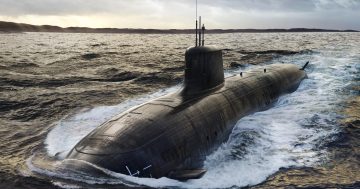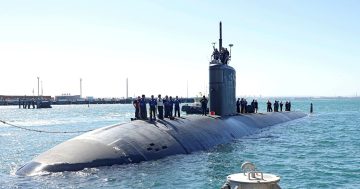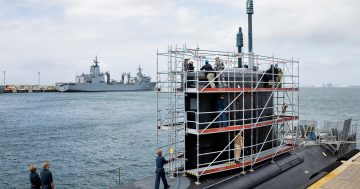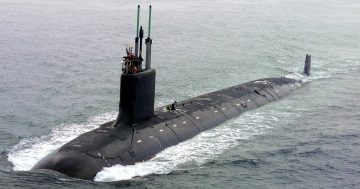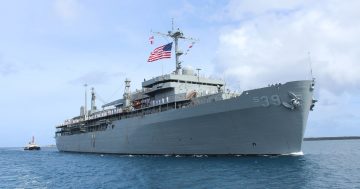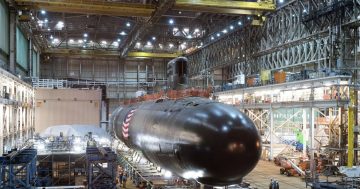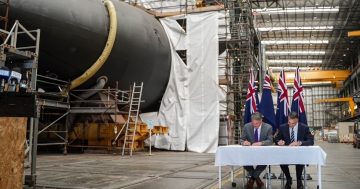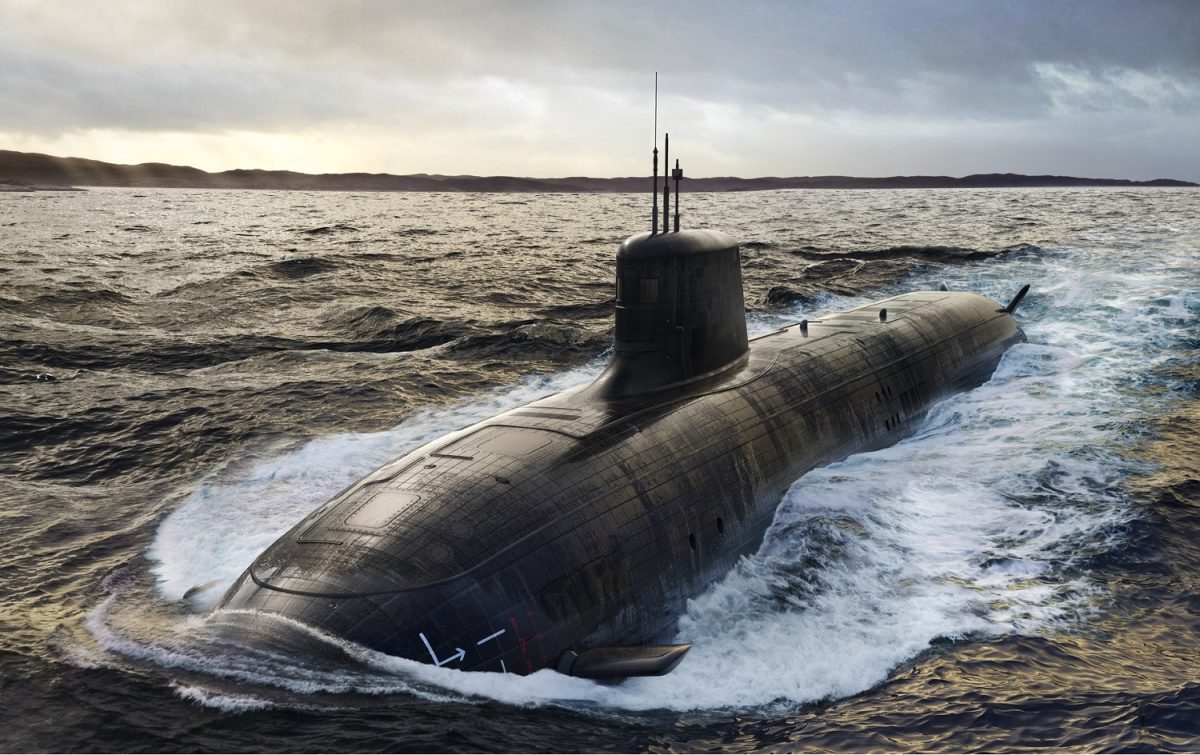
Concept art of the SSN-AUKUS submarine design, formerly known as the SSN(R). Photo: UK MoD.
Now that the three leaders of the AUKUS countries have revealed the basics, it’s time to dig a little deeper into the details of the so-called “optimal pathway” the partners are taking for Australia to successfully acquire a nuclear-powered submarine capability.
The path will be a three-phased effort interspersed with various elements such as training, base infrastructure and manufacturing facilities.
Phase one is expected to commence in 2027 when the AUKUS partners start a rotational presence of US Navy Virginia and Royal Navy Astute-class nuclear-powered attack submarines (SSNs) at HMAS Stirling near Fremantle.
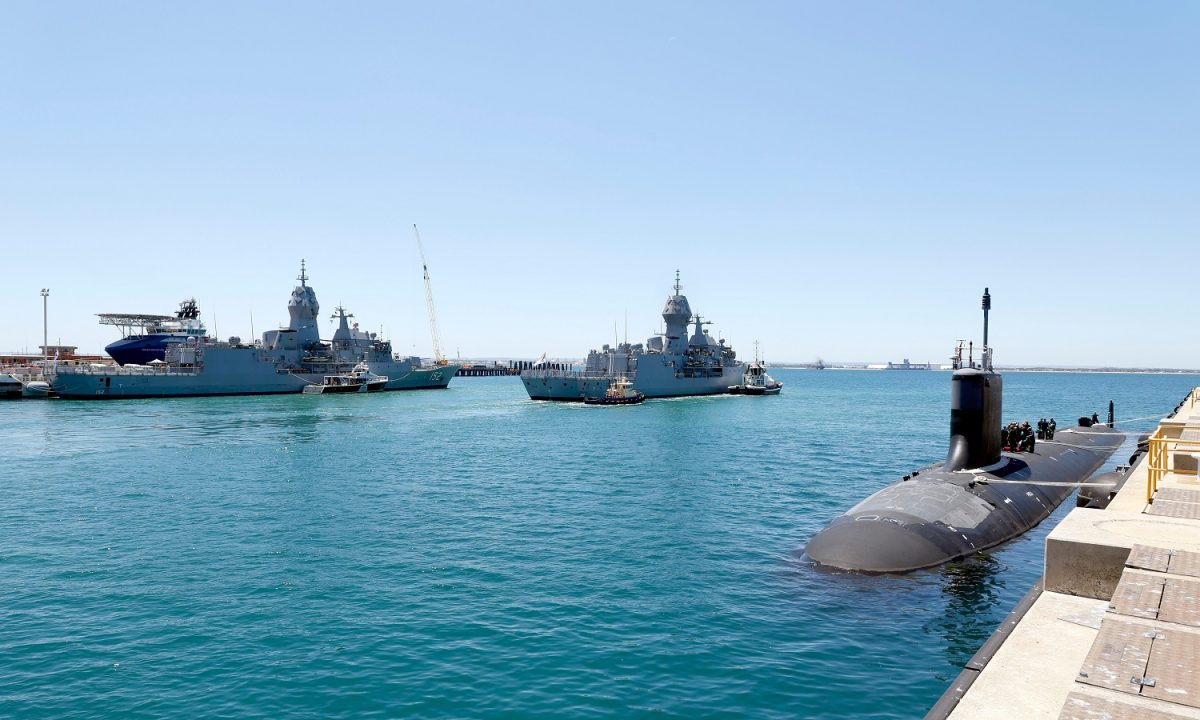
US Navy Virginia-class submarine USS Mississippi at HMAS Stirling. Photo: ADF.
Known as the ‘Submarine Rotational Force-West’ (SRF-West), this presence is designed to help Australia build operational capabilities and skills to be ‘sovereign ready’ (that is, learn how to own and operate SSNs safely and securely). SRF-West will also augment Australia’s Collins-class conventional submarine (SSKs) capability on regular exercises and operational patrols in the Indo-Pacific region.
Other elements of Phase one have already commenced, with the placement of Royal Australian Navy sailors within the US and UK submarine forces and in nuclear power schools. Australian workers are expected to start working in the US shipyards this year, while the facilities at HMAS Stirling will be upgraded to accommodate visiting and permanently based SSNs.
Phase two will see Australia acquire between three and five Virginia-class SSNs from the US from 2032. While still subject to US congressional approval, this capability should arrive nearly a decade sooner than earlier estimates and will enable the withdrawal from service of some of Australia’s Collins-class boats.
Australia’s ambassador to the US, Arthur Sinodinos, told the media on Tuesday morning that he was confident of congressional approval.
“We have very strong support in the Congress,” he said. “What’s important to understand is the support for Australia in [the US] is bipartisan. It’s very strong. And we’ve had a lot of engagement with the Congress.”
The approach will “deliver to Australia that capability far more quickly than even we thought possible when we originally and initially launched this partnership”, a senior Biden administration official told a media briefing shortly before Tuesday’s announcement, “and it will result in all three nations lifting their game in their respective submarine industrial bases. And it will involve a level of sensitive, sophisticated technological cooperation that is almost without precedent”.
It’s likely some or all of the Virginia boats will be former US-Navy boats.
“We might get new ones off the production line but, by all accounts, the US is having difficulty ramping up production, so it seems more likely we’ll get second-hand ones,” Sarah Pavillard, the founder and CEO of defence services company Adroita, told Region.
“But one of the challenges for an older vessel would be, not only will we have our ‘L’ plates on in operating them, but the boats themselves will be at the tail end of the life cycle ‘bathtub curve’ where we start seeing higher rates of failure of various components and systems,” she added.
Ms Pavillard is also a board member of the Submarine Institute of Australia (SIA) and the Australian Industry & Defence Network (AIDN).
The Biden administration official described the AUKUS submarine deal as “far more than simply a defence program”.
“It is arguably the most prominent example of President Biden’s commitment to invest in and modernise our alliances,” he said.
“AUKUS builds upon the UK’s relatively recent strategic engagement in the Indo-Pacific and ensures it will be a lasting presence going forward and brings another European partner into our engagement in Asia. It makes Australia a major contributor to Indo-Pacific security and stability, and it binds the three of us together in ways almost unimaginable for the foreseeable future.”
Sarah Pavillard agrees.
“We’ve been hearing a lot about interoperability, but we’re starting to hear the term ‘interchangeability’,” she explained.
“What that means and how people are defining it is less clear, but being in lockstep with US combat system programs and the evolution of those systems will be absolutely critical for achieving the strategic goals of AUKUS.
“This has raised questions around sovereignty, but interchangeability doesn’t mean the warfighting concepts and responsibilities of Australian officers in command will be undermined,” she said.
“In terms of the concept of integration, the rules of the game are set before you exercise or are in a warfighting situation and are prepared well in advance.”
Phase 3 will see Australia join with the US and UK in designing and developing the next-generation SSN-AUKUS boats.
Designed to replace the UK’s Astute boats in service, the SSN-AUKUS will combine UK and US hull, propulsion, combat system, weapons and sensor technologies and will be operated by the UK and Australia. While the US is developing its own SSN(X) design, the two designs will likely share many systems, bringing economies of scale across the two programs.
“SSN-AUKUS will be built and deployed by both Australia and the UK,” the administration official said.
“The UK intends to deliver its first SSN-AUKUS domestically in the late 2030s. Australia intends to deliver the first SSN-AUKUS built in Australia to the Royal Australian Navy in the early 2040s. This is going to require significant improvements in industrial bases in all three countries … We have briefed Congress on this plan and see strong bipartisan support.”
In a 14 March release, the Australian Industry and Defence Network (AIDN) welcomed the announcement.
“AIDN looks forward to having the opportunity to work closely with government and Defence on ensuring that Australian industry, in particular the SME community, are able to compete in a fair and equitable way to secure meaningful work in this program,” it said.
“This is a unique opportunity for Australia, the US and the UK to develop a common supply chain to ensure that the full benefits of AUKUS can be realised,” AIDN’s statement said.
“The Albanese Government can ensure that a truly sovereign national industrial capability can be achieved. It is imperative that the Australian Government works closely with our partner governments to ensure that Australian industry is front and centre for all discussions.”
In a 14 March article for the ABC, former Australian Army Major General and commander of the Australian Defence College in Canberra Mick Ryan described the submarine deal as “one of the most momentous announcements about the national security of Australia in the history of our nation”.
“The cost of the project is massive,” he said. “At $368 billion out to 2055, there is no other Australian endeavour with which to compare this undertaking.
“Over 32 years, this represents as much as $11 billion per year,” he added.
“The current defence budget (including the Department of Defence and the Australian Signals Directorate) is $48.6 billion, or 2.11 per cent of GDP. The cost of submarines will add up to half a percentage point of GDP to this figure.
“Given the eye-watering expense, it is probable that the Australian Defence Force will need to be reshaped and restructured to afford it. Even if there are rises in defence spending announced in the forthcoming Defence Strategic Review, the nuclear-powered submarines are going to absorb every spare dollar, and many other dollars already being spent on defence in other ways.”












